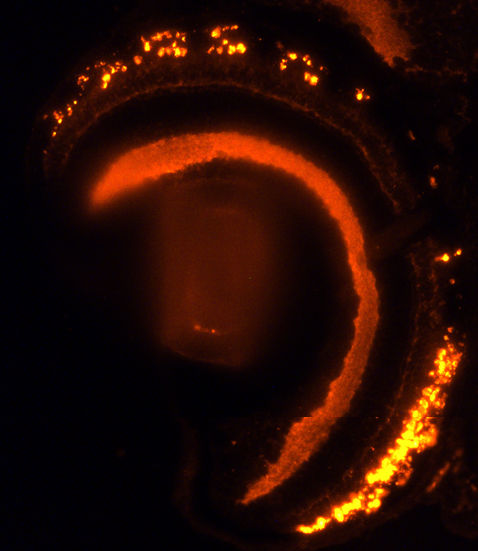
Photoreceptor Determination and Differentiation
Vertebrate vision is mediated by the function of rod and cone photoreceptors, and each species generates and maintains characteristic ratios of rods to cones, and of specific cone subtypes with different spectral sensitivities. We are using the zebrafish as a model system for probing the mechanisms that regulate the production and spatial patterns of the different photoreceptor types. The current approaches include transcriptomics, and manipulation of developmental signaling systems that regulate the expression of the cone opsin genes.
Collaborators:
Diana Mitchell, University of Idaho
Shoji Kawamura, University of Tokyo
Anand Swaroop, National Eye Institute
M. Valeria Canto-Soler, Johns Hopkins Medical Institutions






Retinal Regeneration
Zebrafish are able to regenerate their retinas after lesions that destroy neurons. Using behavioral assays we have documented the loss and recovery of visual function. This functional recovery takes place despite the presence of histological errors in the regenerated retina. Current studies are focused upon the morphologies of regenerated bipolar neurons, their connections to synaptic partners, and the role of the immune system during the process of regeneration.
Collaborators:
Diana Mitchell, University of Idaho
Peter Fuerst, University of Idaho






Vascular-neural interactions
Tissue-tissue interactions are important for the morphogenesis and differentiation of tissues of the vertebrate eye, but roles for the ocular vasculature have been difficult to study due to metabolic functions of the vasculature to supply oxygen and nutrients. In zebrafish embryos, however, the vasculature can be manipulated without causing tissue hypoxia, because diffusion is sufficient for gas and nutrient exchange. We are using temporally-selective manipulations of the vasculature, along with specific zebrafish mutants, to determine components of the vasculature that are required for retinal differentiation.
Collaborators:
Adi Inbal, Hebrew University of Israel






Evolution in visually challenging environments
In a multi-institution collaborative project, we are studying the visual systems of threespine stickleback that have recently colonized turbid glacial waters of Iceland.
Collaborators:
Jenny Boughmann, Michigan State University
Hans Hofmann, University of Texas, Austin
Through additional collaborations within the UI's Center for Modeling Complex Interactions (CMCI), we are developing strategies to predict peak spectral sensitivity of cone visual pigments using homology modeling and molecular simulations.
Collaborators:
Jagdish Patel, University of Idaho
Celeste Brown, University of Idaho
Analysis of rod-mediated color vision in deep sea fish.
Collaborators:
Walter Salzburger, University of Basel, Switzerland
Zuzana Musilova, Charles University, Prague, Czech Republic
Fabio Cortesi, University of Queensland, Brisbane, Australia





